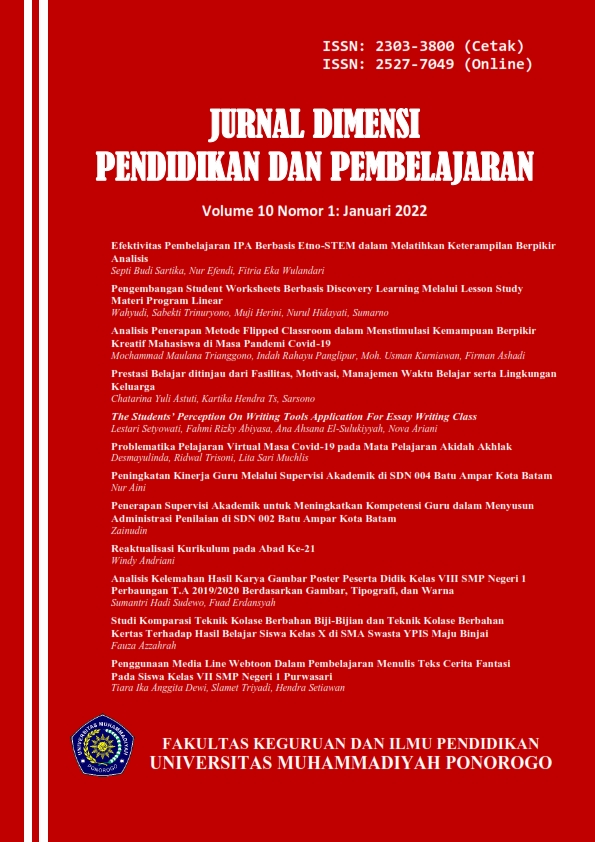Analisis Penerapan Metode Flipped Classroom dalam Menstimulasi Kemampuan Berpikir Kreatif Mahasiswa di Masa Pandemi Covid-19
DOI:
https://doi.org/10.24269/dpp.v10i1.4659Abstract
Abstrak
Pandemi covid-19 mengubah paradigma pendidikan menjadi pembelajaran yang berorientasi pada pemanfaatan teknologi. Metode pembelajaran flipped classroom dikembangkan untuk menjawab permasalahan yang muncul akibat penerapan pembelajaran daring. Banyak perubahan pola pikir sebagai hasil dari penerapan pembelajaran daring, salah satunya adalah kemampuan berpikir kreatif. Tujuan penelitian ini adalah untuk menganalisis penerapan metode flipped classroom dalam menstimulasi kemampuan berpikir kreatif mahasiswa. Jenis penelitian ini menggunakan mixed methods dianalisis secara kualitatif dan kuantitatif dengan menggunakan teknik observasi, wawancara, dan studi dokumentasi. Hasil analisis menunjukkan bahwa metode flipped classroom memberikan ruang dan kesempatan bagi mahasiswa untuk melatihkan kemampuan berpikir kreatifnya pada setiap fase yang ada pada metode flipped classroom, sehingga metode flipped classroom dinilai mampu menstimulasi kemampuan berpikir kreatif mahasiswa di masa pandemi covid-19.
Â
Abstract
The COVID-19 pandemic has changed the paradigm of education into technology oriented learning. The flipped classroom learning method was developed to answer the problems that happen due to the application of online learning. Many changes in mindset as a result of the application of online learning, one of which is the creative thinking skills. The purpose of this study was to analyze the application of the flipped classroom method in stimulating students' creative thinking skills. This research was analyzed qualitatively by using observation, interview, and documentation studies. The results of the analysis show that the flipped classroom method provides space and opportunities for students to practice their creative thinking skills in every phase of the flipped classroom method, so that the flipped classroom method is considered capable of stimulating students' creative thinking skills during the covid-19 pandemic
References
Davies RS., Dean DL., B. N. (2013). Flipping the classroom and instructional technology integration in a college-level information systems spreadsheet course. Educ Technol Res Dev, 61(4), 563–580. https://doi.org/10.1007/s11423-013-9305-6
Ennis, R.H. (1995). Critical Thinking. New York: Prentice Hall.
Miles, M. B., & Huberman, M. A. (1994). Qualitative data analysis: an expanded sourcebook (2rd ed). London: Sage Publication.
Milman, N. B. (2012). What Is it and How Can it Best be Used ? Distance Learning, 9(3), 85–88.
Sohrabi, B., & Iraj, H. (2016). Computers in Human Behavior Implementing fl ipped classroom using digital media : A comparison of two demographically different groups perceptions. Computers in Human Behavior, 60, 514–524. https://doi.org/10.1016/j.chb.2016.02.056
Trianggono, M. M. (2017). Analisis Kausalitas Pemahaman Konsep Dengan Kemampuan Berpikir Kreatif Siswa Pada Pemecahan Masalah Fisika. Jurnal Pendidikan Fisika Dan Keilmuan (JPFK), 3(1), 1. https://doi.org/10.25273/jpfk.v3i1.874
Trianggono, M. M. (2018). Seminar Nasional Pendidikan Fisika 2018 Seminar Nasional Pendidikan Fisika 2018. 3(2), 162–166.
Trianggono, M. M. (2020). Stimulasi Perkembangan Kreativitas Mahasiswa PG PAUD Melalui Pembelajaran Sains Berbasis Proyek Pengembangan Media. PAUD Lectura: Jurnal Pendidikan Anak Usia Dini, 4(01), 1–10. https://doi.org/10.31849/paud-lectura.v4i01.4234
Tucker B. (2012) The flipped classroom. EdNext. 12(1) :82-3
Downloads
Published
Issue
Section
License
Copyright
Authors who publish their manuscripts in this journal agree to the following terms:
- The copyright on each article belongs to the author.
- The author acknowledges that Jurnal Dimensi Pendidikan dan Pembelajaran has the right to be the first to publish under a Creative Commons Attribution 4.0 International (Attribution 4.0 International CC BY 4.0) license.
- Authors may submit articles separately, arranging for the non-exclusive distribution of manuscripts that have been published in this journal to other versions (e.g., sent to the author's institutional repository, publication into books, etc.), acknowledging that the manuscript was first published in the Jurnal Dimensi Pendidikan dan Pembelajaran.
Â
License
Use of the article will be governed by the Creative Commons Attribution license as currently published under the Creative Commons Attribution 4.0 International License (Attribution 4.0 International (CC BY 4.0).
Â
This license permits anyone to copy and redistribute this material in any form or format, compose, modify, and make derivatives of this material for any purpose, including commercial purposes, as long as they give credit to the author for the original work.

